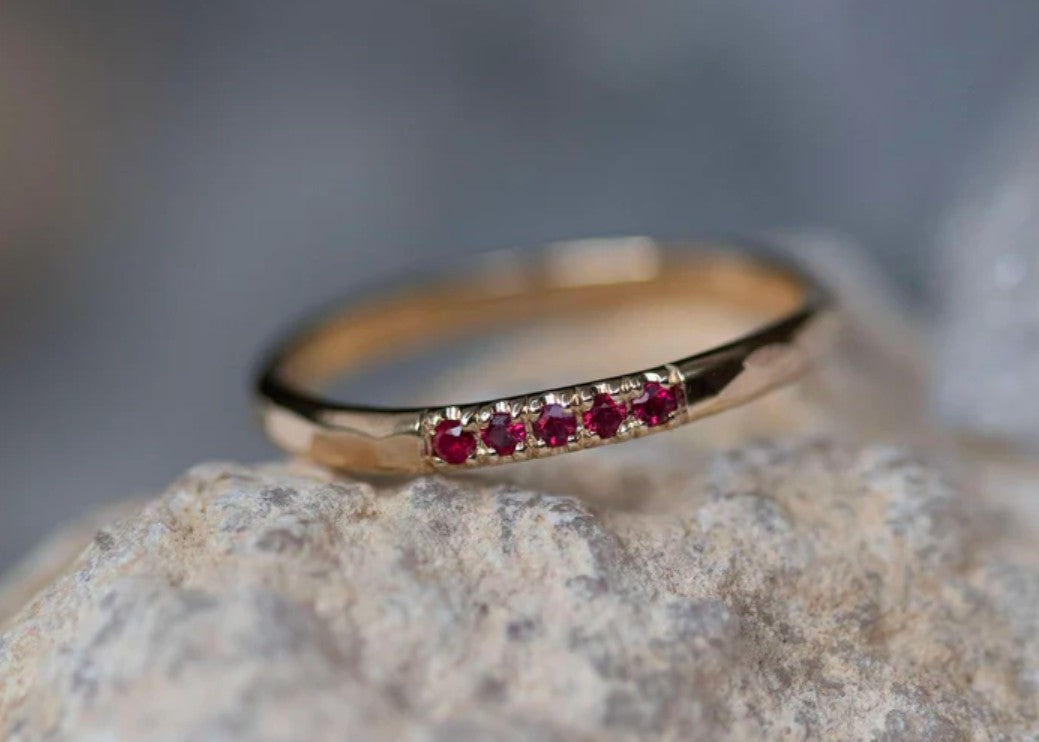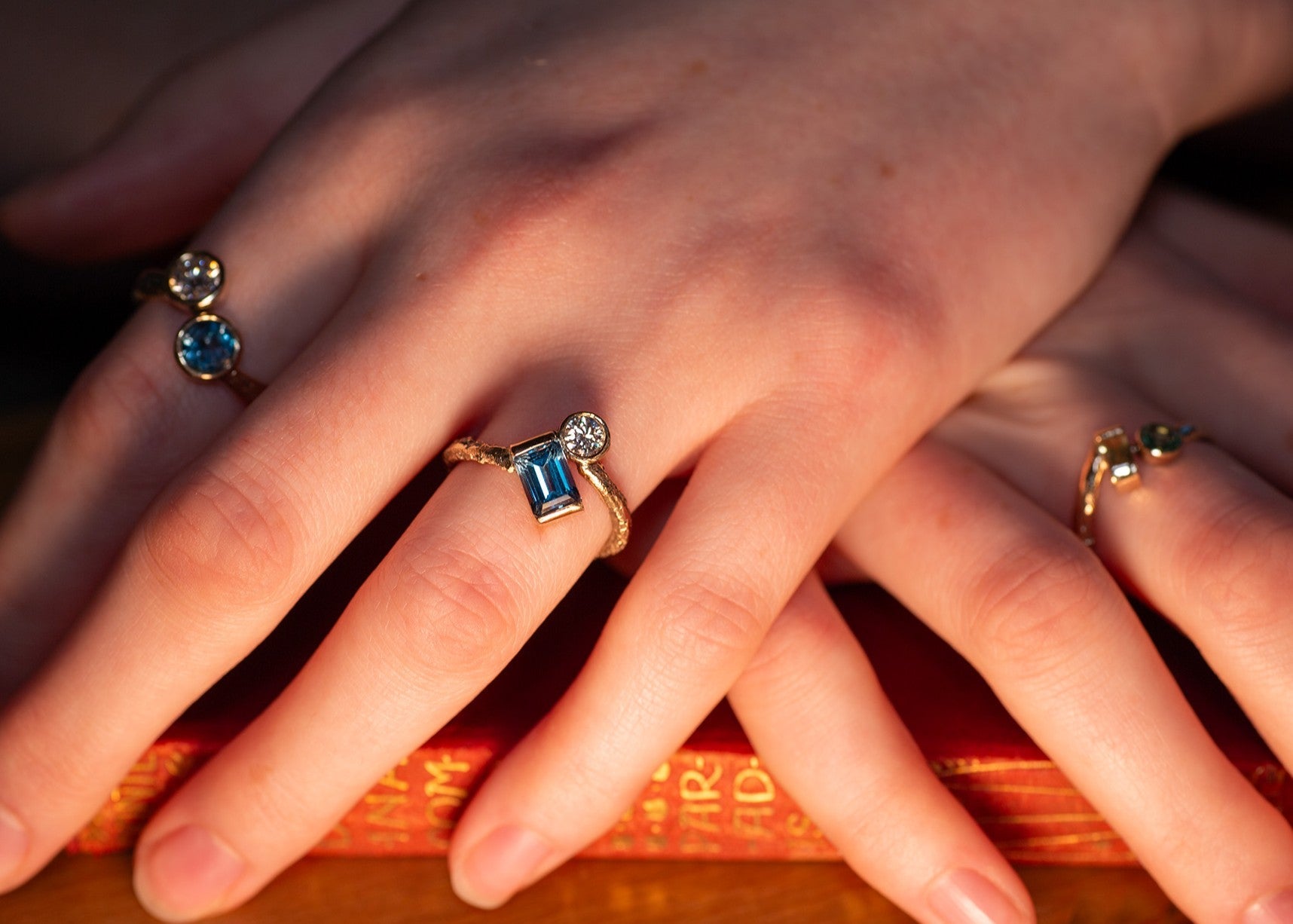In this blog, we delve into how pivotal styles like Art Nouveau, Art Deco, and lesser-known but equally impactful movements such as Constructivism and Cubism, have shaped the aesthetic and conceptual approach to creating jewellery. Each section uncovers the unique characteristics of these art movements and their influence on the jewellery we wear.
Art Nouveau
Characterised by organic forms and flowing lines, Art Nouveau embraced natural motifs and intricate craftsmanship.

Art Nouveau emerged as a distinctive art style at the turn of the 20th century, renowned for its flowing lines and organic forms inspired by nature. Characterised by its elegant curves and use of motifs such as flowers, leaves, and vines, Art Nouveau was a departure from the rigid designs of the industrial age, emphasizing artistic freedom and natural beauty. This movement sought to erase the boundaries between fine arts and applied arts, making it particularly influential in the world of decorative arts, including jewellery.
In jewellery, Art Nouveau introduced pieces that were not only adornments but also works of art. Designers embraced the fluidity of the style to create intricate pieces that often featured natural elements such as dragonflies, orchids, and peacocks. The use of new materials and techniques allowed for the creation of softer, more malleable forms, making each piece unique. Enamelling became popular during this period, adding vibrant colour and texture to the designs.
Cubism
Cubism revolutionised art by presenting subjects in fragmented, geometric forms, thereby altering traditional perspectives and heralding the rise of modern abstraction.

Cubism, pioneered by Pablo Picasso and Georges Braque in the early 20th century, radically broke from traditional art by depicting subjects from multiple viewpoints to represent form in a two-dimensional flat plane. This movement fragmented the world into geometric shapes, reassembling it in abstracted forms and collages that challenged conventional representations of perspective and dimension. Cubism influenced painting, sculpture, and design, setting the stage for modern abstract art by emphasizing the synthesis of different perspectives into a cohesive whole.
Art Deco
Defined by bold geometry, sharp lines, and lavish ornamentation, Art Deco epitomised luxury, glamour, and exuberance of the early 20th century.

Art Deco emerged in the 1920s and 1930s, bringing with it a style that was all about bold geometry, symmetry, and contrast. This movement, which originated in France before spreading worldwide, was influenced by the modernisation of technology and the excitement of the Jazz Age. Characterised by its sharp lines and blocky forms, Art Deco represented elegance, glamour, and functionality. The style extended beyond architecture and interior design to deeply influence jewellery design, which embraced this new aesthetic with open arms.
In the realm of jewellery, Art Deco marked a departure from the flowing motifs of Art Nouveau, introducing instead a focus on streamlined, polished pieces that highlighted stark contrasts and geometric patterns. Common elements included angular shapes, stepped designs, and the extensive use of diamonds and platinum. Jewellers also frequently incorporated vibrant, contrasting gemstones like rubies, sapphires, and emeralds to create striking pieces that captured the exuberance and forward-thinking spirit of the era.
Bauhaus
Focused on functional simplicity and integration of technology, Bauhaus promoted a harmony between art's function and its design.

Bauhaus, established in 1919 in Germany, was revolutionary in its approach, blending art with industry and functionality. The movement's philosophy was rooted in the idea of creating 'total' works of art in which every element was considered part of a greater whole. Bauhaus aimed to merge practical crafts with fine arts, bringing an emphasis on simplicity, rationality, and functionality. This ideology extended into various domains, including architecture, furniture design, and notably, jewellery, where Bauhaus principles reshaped traditional aesthetics.
In jewellery design, the Bauhaus influence was characterised by clean lines, geometric forms, and a focus on materials and craftsmanship rather than ornate decoration. Bauhaus jewellers pioneered the use of non-precious materials such as steel and glass, reflecting the movement’s ethos of accessibility and the unification of art and industrial techniques. These pieces were designed to be as functional as they were beautiful, embodying the Bauhaus commitment to practicality and minimalism.
Minimalism
Minimalism is an art movement that emphasizes extreme simplicity in form and function, removing all non-essential elements to highlight the artwork’s fundamental aspects.

Minimalism, emerging in the 1960s, is an art movement characterized by its extreme simplicity of form and a deliberate lack of expressive content. Focusing on the essentials of shape, colour, and texture, Minimalism strips away all surplus detail to emphasize the purity of the artwork itself. Artists like Donald Judd, Sol LeWitt, and Frank Stella sought to remove any personal expression from their works, allowing the viewer to experience the art without the interference of complex themes or the artist’s emotional involvement. This movement profoundly influenced not only visual art but also design and architecture, promoting a style defined by cleanliness, order, and harmony.
Modernism
Modernism is known for its minimalist aesthetic that emphasised clean lines and functionality without excessive decoration.

Modernism in jewellery design took shape primarily in the mid-20th century, reflecting the broader Modernist ethos of simplicity and functionality that permeated art, architecture, and design. This movement sought to strip away the excesses of previous styles and focus on minimalistic forms, embracing the idea that 'less is more'. In Britain and across Europe, this translated into jewellery that favoured clean lines, abstract forms, and an emphasis on the intrinsic beauty of the materials used, often showcasing the craftsmanship and the materials themselves without unnecessary decoration.
Modernist jewellers experimented with both traditional and unconventional materials, often choosing to highlight the contrast between them. Designs were typically sleek, with a strong focus on form and structure, which allowed for new levels of artistic expression within a minimalist framework. This era in jewellery design paved the way for contemporary explorations into what jewellery could represent, moving beyond mere ornamentation to become a form of wearable art.
Postmodernism
Postmodernism is marked by its eclectic mix of styles, complexity, and contradiction, often incorporating a playful approach to traditional forms.

Postmodernism emerged in the latter half of the 20th century as a reaction against the strict, functional principles of Modernism, bringing with it an era of bold experimentation in the arts. Characterised by its eclectic approach and challenging of traditional aesthetics, Postmodernism embraced irony, playfulness, and a bricolage of styles. In jewellery design, this meant a departure from the minimalist and often restrained designs of the previous decades, allowing for more expressive, whimsical, and sometimes irreverent creations.
In the context of jewellery, Postmodernism allowed designers to explore a vast array of materials, from high-end gems to non-traditional elements like plastic, glass, and recycled materials. This period saw an explosion of colour and form, with designers mixing historical elements with contemporary themes to create unique, statement pieces that often carried a narrative or commentary. The result was highly individualistic jewellery that resonated with a cultural shift towards personal expression and rejection of mass-produced uniformity.




